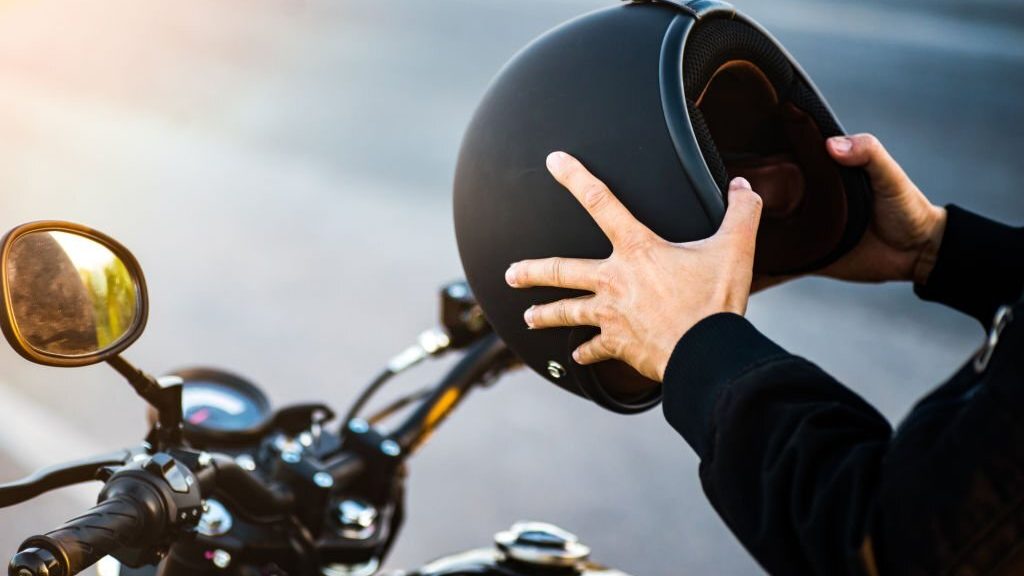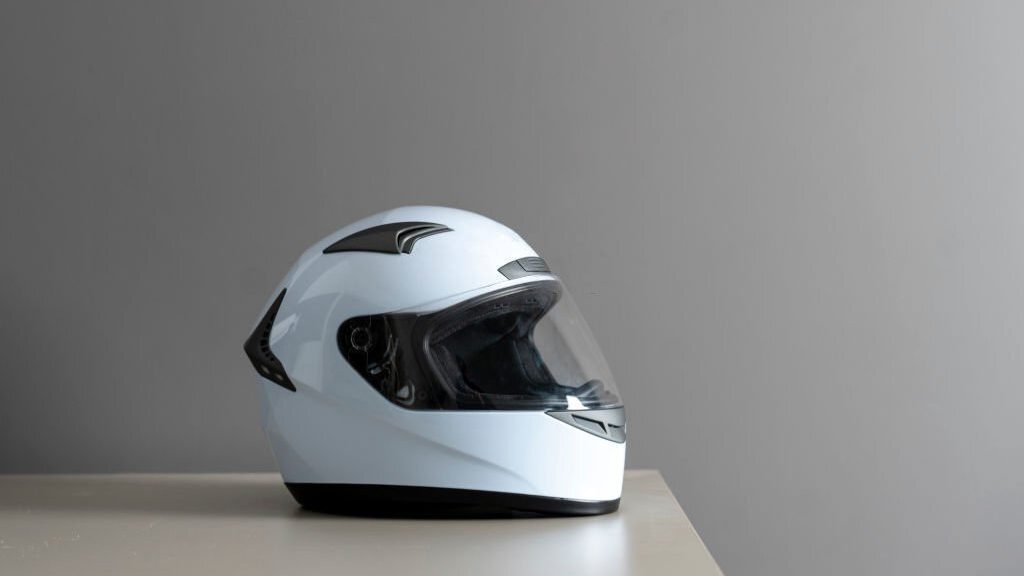As a motorcycle rider, one of the most important safety precautions you can take is wearing a helmet. However, simply wearing a helmet is not enough; it’s essential that the helmet fits properly and is snugly fastened.
The big question is: how tight should a helmet be?
It’s a common concern among riders and a crucial one that needs to be addressed. A too-loose helmet can slip off during an impact, while a too-tight helmet can cause discomfort and even headache.

In this blog, we will dive into how tight a helmet should be for maximum safety and comfort while riding.
How Snug Should a Full-Face Motorcycle Helmet Fit? How Tight Should Full-Face Helmet Fit?
When donning a helmet for motorcycle adventures, achieving the perfect fit is vital for your safety and comfort. You cannot compromise on this! Your helmet must securely encase your head, free from any loose play that could result in serious injury in an accident.
To determine if your helmet is fitting snugly enough, give it a gentle nudge and confirm whether there is any movement.
However, be sure to do it and avoid getting a too-tight helmet, as this can trigger unbearable headaches and unbearable discomfort while cruising down the road.
For optimal results, your helmet must be snug and comfortable without causing undue pressure points or discomfort around your facial features, including your jaw, chin, or other parts of your head.
Overall Helmet Fit
A properly fitting helmet should sit level on your head, with no pressure points or gaps between the helmet and your skin.

It should also feel snug but not tight, with enough room for you to wear a balaclava or thin beanie if needed.
Start by measuring your head and consulting the manufacturer’s sizing chart to ensure a proper fit.
Try several sizes and models to find the best fit when trying on helmets. You should feel even pressure all around your head, without any discomfort or hot spots.
Should a Full-Face Helmet Squeeze Your Cheeks?
It should be snug enough to squeeze your cheeks but not so tight that it causes pain or discomfort. This ensures that the helmet stays securely in place in an accident.
However, it’s important to note that too tight of a helmet can also be a problem, causing headaches or even dizziness.
Additionally, some riders may benefit from motorcycle helmet wraps for a more comfortable fit. Overall, finding the right fit is crucial for both comfort and safety on the road.
Is It Normal for a Helmet to Be Tight?
The obvious misconception often happens to many helmet-wearing enthusiasts is the unnecessary assumption that their cranial protectors are inadequately sized due to tightness upon initial donning.

Nonetheless, it must be emphasized that full-face helmets are expressly designed to be snug, with the padding and cheek pads gradually conforming to the unique shapes of one’s head over time.
Conversely, a too-loose helmet poses far more danger, as it risks abruptly detaching itself from the wearer’s skull in a collision or other catastrophic circumstance.
Is It Better for a Helmet to Be Too Small or Too Big?
A too-small helmet can cause discomfort and pain, especially around the cheeks. On the other hand, a too-big helmet can be loose and may not provide adequate protection in an accident.
Measuring your head and choosing a helmet that fits snugly but is not too tight is essential. A properly fitting helmet should be snug around the cheeks and the top of the head while allowing room for movement.
Do Motorcycle Helmets Loosen Up Over Time?
It is crucial to ensure that your helmet fits well for optimal protection. However, as a helmet is worn, it tends to loosen up over time.

This is primarily due to the padding inside compressing with repeated use.
Replacing your helmet every five years is recommended, regardless of wear and tear. The lifespan of a helmet depends on the frequency of use and the intensity of impact.
It is essential to check the manufacturer’s guidelines to determine how long a motorcycle helmet is good for.
How To Fit a Helmet If You Wear Glasses?
If you wear glasses, fitting a motorcycle helmet can be challenging.
To ensure a proper fit, place the helmet on your head before putting on your glasses. Adjust the helmet straps until they are comfortably snug around your head without causing tightness, discomfort, or pain.
The helmet should sit level on your head, with the chin strap securely fastened. If your glasses press uncomfortably against your ears, try adjusting the position of the helmet to alleviate pressure.
How To Know If Your Motorcycle Helmet Fits Right

When it comes to motorcycle safety, wearing a helmet is non-negotiable. However, more than simply owning a helmet is required – you must ensure that it fits properly to provide maximum protection.
Here are some tips on how to know if your motorcycle helmet fits right:
Try The Helmet On
The first step is to put the helmet on your head and fasten the chin strap. Make sure it sits snugly on your head without any pressure points. You should also be able to see clearly without the helmet obstructing your vision.
Cushions Should Align Perfectly With Your Cheeks
The cushions inside the helmet should align perfectly with your cheeks without any gaps. This is important because the cushions absorb the impact in a crash.
Move the Chin Strap Around
Once the helmet is on, move it around to ensure it’s not too loose or tight. You should be able to fit two fingers between the strap and your chin comfortably.
Keep The Helmet on For 15-30 Minutes
It’s important to keep it on for a while to ensure it’s comfortable and doesn’t cause any pressure points. This is especially important if you wear the helmet for long rides.
Finding the Right Motorcycle Helmet Shape

Round Oval– Round all the way
The critical aspect to consider when searching for the ideal motorcycle helmet shape is your head shape. A circular-shaped head will necessitate a helmet with a round, oval configuration that will conform flawlessly to your head.
This type of helmet is engineered to provide the ultimate comfort, guaranteeing a tight fit without any uncomfortable pressure points.
However, if you have a head with a narrow or long oval shape, it is crucial to note that there may be better choices than a round, oval helmet for you.
It is imperative to select a helmet that is specifically tailored to your unique cranial shape to ensure maximum comfort and protection.
Intermediate Oval– Narrower in the front and back and roundish in the middle
If you have a head shape that’s narrower in the front and back and roundish in the middle, an intermediate oval helmet will be the perfect fit for you.
This type of helmet is designed to provide a secure fit around the forehead and back of the head while leaving enough room in the middle to prevent any pressure points.
An intermediate oval helmet is a popular option among motorcycle riders because it provides a comfortable and secure fit while offering excellent protection.
Long Oval– Narrower in the front, middle, and back
If you have a head shape that’s narrower in the front, middle, and back, a long oval helmet will be the perfect fit for you.
This type of helmet is designed to provide a secure fit around the head’s forehead, middle, and back while leaving enough room on the sides to prevent any pressure points.
A long oval helmet may not be the best option if you have a round-shaped head.
Additionally, consider the anti-fog feature when choosing a helmet to ensure clear vision during the ride.
Tips for How to Wear Your Motorcycle Helmet Correctly on Your Head

Here are some tips for ensuring your motorcycle helmet fits correctly:
- Measure your head before purchasing a helmet to ensure you get the right size.
- The helmet should fit snugly but be tight enough. It should not move around on your head, and the padding should be comfortable.
- Check the chin strap to ensure it is securely fastened and not too loose.
- The helmet should sit level on your head, not tilted forward or backwards.
- Ensure the helmet does not obstruct your vision and that you can move your head comfortably.
- Consider trying on different helmet brands or models to find the best fit for your head shape.
- Check the helmet’s fit regularly, especially if you have lost weight or changed hairstyles.
- Properly fitting your motorcycle helmet is essential for your safety while riding, as a loose or ill-fitting helmet can be dangerous. Always prioritize safety over style when it comes to choosing a motorcycle helmet.
What’s the Best Way to Break in a Motorcycle Helmet?
When it comes to breaking in a motorcycle helmet, the safest way to do so is by wearing it. It’s important to ensure that the helmet is properly fitted, neither too tight nor too loose, to provide optimal protection.
A helmet that’s too tight can cause discomfort and even headaches, while a loose one can lead to head shake and reduced protection in the event of an accident.
Do Motorcycle Helmets Stretch?
While it’s true that helmets can stretch over time to accommodate the shape of your face, it’s important to avoid forcing the issue.

Intentionally stretching your helmet using objects or manipulating the internal padding can compromise its structural integrity and leave you vulnerable in an accident.
To ensure the best protection, always purchase a helmet in the correct motorcycle helmet size that fits snugly without being too tight or uncomfortable.
Motorcycle Helmet Fit FAQs
To put on a motorcycle helmet, first, loosen the chin strap and place the helmet over your head. Then, fasten the chin strap and adjust the helmet to fit snugly on your head.
Helmets are designed to absorb impact by breaking or deforming upon impact. This is to protect the wearer’s head and prevent serious injuries.
To determine if a helmet fits properly, it should be snug but not too tight. Check for gaps between the helmet and your head, and make sure it doesn’t shift around when you move.
Shoei helmets are known to run true to size, so it’s recommended to measure your head and consult their sizing chart before purchasing.
If you want to know your head shape for a motorcycle helmet, start it above your eyebrows and circle it around the back of your head.
To improve your helmet fit, consider adjusting the cheek pads or adding extra padding. You can also try wearing a balaclava to create a snugger fit.
Wrapping Up!
Wearing a motorcycle helmet that fits snugly and comfortably ensures maximum safety and protection. It should feel tight enough to stay securely in place during impact yet not so tight that it causes discomfort or headaches.
Remember that different helmet brands and models may have slightly different fits, so it’s essential to try on multiple options and consult with a professional if necessary.
Have you ever had trouble finding a helmet that fits just right? What strategies have you used to find the perfect fit for your head shape and size?


Comments are closed.